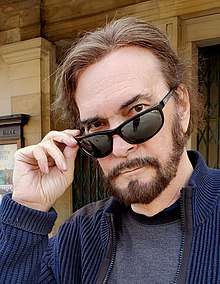Paul Norman (game designer)
Paul Norman (born December 18, 1951) is an American musician, composer, and computer programmer. Active in music since 1970, he has been involved with the development of computer entertainment and information since 1982.

Biography
After fifteen years as a professional touring and studio musician, Norman programmed his first major computer program during the 1980s, a video game called Forbidden Forest. Norman's stated aim was to create an almost-cinematic experience and relied on 6502 machine language when programming the game. Forbidden Forest was originally developed for a company called Synchro that went out of business when the game was around three-quarters complete, creating a major issue for Norman, but was eventually bought out by Cosmi who saw the game to completion.[1] One year after release, Forbidden Forest was selling hundreds of thousands of copies worldwide, and the widespread popularity of the game ensured a receptive audience for Norman's second title, Aztec Challenge.
Norman's graphic adventure games saw a particularly enthusiastic response from audiences in Europe. Following the success of Aztec Challenge, Norman developed another melancholic, cinematic-esque game titled Caverns of Khafka,[2] that was based on an Atari 8-bit computer game of the same name by Robert Bonifacio.[3] Though Norman personally eschewed the "programmer" label, his skillset as a computer entertainment developer allowed him to make what he affectionately referred to as "little 16-color 'films'". Norman's growing expertise with computer languages and their logic made it easier to work on his stories and special effects. The popularity of the television show Airwolf and the movie Blue Thunder inspired Norman to make Super Huey, the first-ever helicopter simulator, which has gone on to sell more than two million copies.
In 1990, Norman joined a CD-ROM development team at Tiger Media[4] , acting as script writer, audio and music producer, creator, and engineer. After two years as design consultant for Sega, he was contracted to produce audio and video content for the Discovery Channel Software title Carriers: Fortress at Sea. In 1995, Norman became a consultant and contributor on internet projects as well as interim contracts for Java programming. In 1999, he produced a complete website for a retail Internet startup, from GUI to database processing. He spent the next two years developing ideas and methods for a better model of Internet presentations and entertainment employing Adobe Flash and Caligari Truespace as tools.
Norman has developed numerous websites for a variety of businesses and celebrities. In 2014 he completed development of a web system for learning to play musical instruments, starting with guitar, piano, and harmonica, based on the theories of Phil Sardo. The website, thesardomethodoflearning.com, was officially launched in July 2014.[5]
Games Developed
| Year | Title |
|---|---|
| 1983 | Forbidden Forest |
| 1983 | Aztec Challenge |
| 1984 | Caverns of Khafka |
| 1985 | Monster Trivia[6] |
| 1985 | Beyond the Forbidden Forest[7] |
| 1985 | Super Huey[8] |
| 1986 | Def Con 5[9] |
| 1986 | Super Huey II[10] |
| 1987 | Chernobyl[11] |
| 1989 | The President Is Missing[12] |
| 1989 | Navy Seal[13] |
| 1991 | Murder Makes Strange Deadfellows |
| 1995 | The Umbra Conspiracy |
| 2003 | Super Huey III |
References
- http://www.retrogamer.net/retro_games80/the-making-of-the-forbidden-forest/
- "IMDB: Caverns of Khafka". IMDb. 2 January 1984. Retrieved 21 October 2014.
- Caverns of Khafka credits for Commodore 64
- http://www.c64.com/interviews/norman.html
- Paul Norman
- http://www.gamebase64.com/oldsite/gameofweek/5/gotw_triviamonster.htm
- https://www.disposablemedia.co.uk/2019/10/heading-beyond-the-forbidden-forest-once-more/
- http://www.gb64.com/oldsite/gotw_superhuey.htm
- https://www.c64.com/interviews/norman.html
- http://www.zzap64.co.uk/cgi-bin/displaypage.pl?issue=021&page=026&thumbstart=0&magazine=zzap&check=1
- https://www.c64.com/interviews/norman.html
- https://www.c64.com/interviews/norman.html
- https://www.c64.com/interviews/norman.html